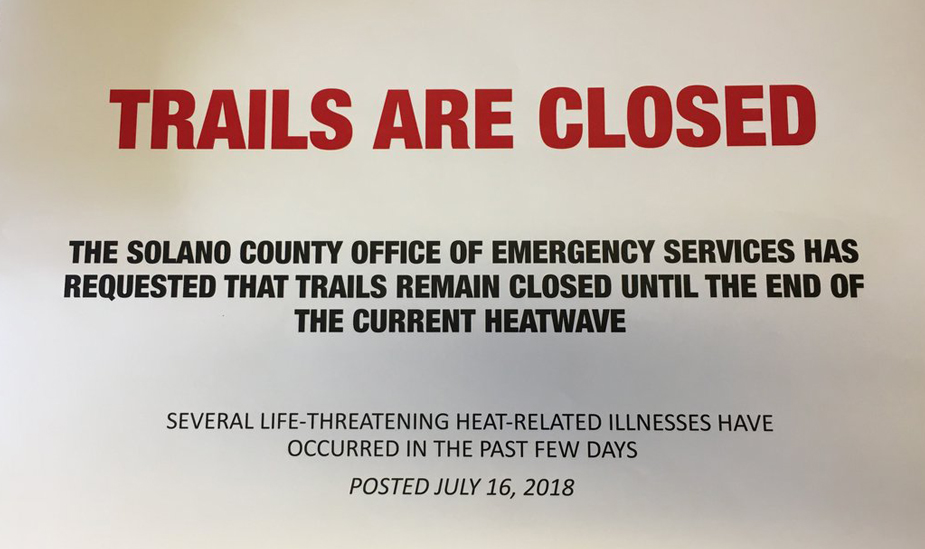The signs went up Monday (July 16) at UC Davis’ Stebbins Cold Canyon Reserve: “Trails Are Closed” — and here’s why: No sooner did a heat wave arrive last weekend than at least two hikers suffered severe heat-related illness at the natural reserve near Lake Berryessa west of Winters.
ANOTHER HEALTH CONCERN
The Sacramento region’s air quality districts have declared Spare the Air for Wednesday (July 18), due to excessive ground-level ozone pollution — the result of high temperatures compounded by smoke drifting in from the Ferguson Fire near Yosemite, with little wind to disperse the pollutants.
People are asked to cut back on driving, say, by putting off errands until another day, or carpooling or taking public transit (everyone rides for free on Unitrans and the North Natomas shuttle). If you’re biking or walking, consider doing so in the morning when pollution levels are lower.
The air districts predicted an Air Quality Index measurement of 126, which is “unhealthy for sensitive groups” — people with heart and lung disease, and older adults and children, all of whom are advised to limit prolonged exertion outdoors.
The Solano County Office of Emergency Services requested that the trails remain closed until the end of the heat wave. A National Weather Service meteorologist predicted the Lake Berryessa area would see a high temperature of 100 degrees on Wednesday (July 18), followed by highs in the low- to mid-90s through July 24.
UC Davis officials concurred on the trail closure. “Our concern is people’s safety,” said Jeffrey Clary, associate director of UC Davis Natural Reserves. Stebbins Cold Canyon has no gates or fences to keep people out, but “our warning signs are there to help people make wise decisions.”
Last Saturday (July 14), amid temperatures at Stebbins Cold Canyon in the upper to mid-90s, emergency personnel responded to the Blue Ridge Loop Trail on two calls of heat stroke, said Howard Wood, chief of the Vacaville Fire Protection District, one of the participating agencies.
In the first call, around 1 p.m., a California Highway Patrol helicopter flew the victim from the trail to a makeshift landing pad at Canyon Creek Resort off Highway 128, and an ambulance took her to a hospital. Around 4 p.m., rescuers assisted another victim, taking her from the trail to the landing pad; a medical helicopter picked her up and took her to a hospital.
“At last report, both had gone home,” said Chief Wood, whose district extends from Vacaville to Lake Berryessa.
Hikers and bicyclists alike, he said, must be very cautious to carry plenty of water in high heat like what the area is experiencing now.
Safety at Stebbins
A trail safety handout cautions about heat danger at Stebbins Cold Canyon: “The fire service performs numerous rescues on this trail every year, most often for heat stroke, a condition that can have lifelong consequences and is potentially fatal.”
The Vacaville Fire Protection District and Solano County Office of Emergency Services started producing the handout two years ago; they distribute copies along with bottles of water on hot weekends, in the Stebbins Cold Canyon parking lot.

Referring to the Blue Ridge Loop (5 miles with 1,600 feet of climbing), the safety handout advises people to start early enough so as to complete the three-hour hike before the temperature reaches 80 to 85 degrees. Often this means starting no later than 9 a.m., earlier on some days.
For hikers not used to strenuous exercise in significant heat, officials encourage shorter training hikes. “It requires exercising one to two hours a day in 80- to 95-degree heat for 10 to 14 days to become fully acclimated to exercising in heat,” the safety handout states.
One more bit of advice: When starting the Blue Loop Trail, you’ll come to the reserve’s old homestead at about the 1-mile mark — and it’s a good place to turn around if you are winded, fatigued or overheated.
The safety handout also advises:
- Children and people unaccustomed to exercising in heat are particularly susceptible to heat illness.
- Take a minimum of 2 quarts of water per hiker.
- Use forecast sites like Weather Underground to help decide on a safe time frame to start and complete the trail.
See and download the trail safety handout.
Know the signs
UC Davis Health offers important advice for hikers and others to consider when exercising in hot weather.
“Exercise and activity are crucial to help you stay healthy, but it’s important to be careful in the summer to avoid heat stroke, dehydration and other consequences of overexertion,” said Jeff Tanji, a physician who specializes in sports medicine. “Luckily, a little common sense goes a long way.”
EXERCISING SAFELY
UC Davis Health physician Jeff Tanji offers tips to beat the heat:
- Time it right
- Don’t forget regular time-outs
- Stay hydrated
- Dress for the occasion
Read more in “Exercising Safely in Summer Heat” (UC Davis Health news release, June 29).
Conditions such as muscle cramps, heat exhaustion and heat stroke often occur in people working hard or exercising in hot weather, but they can arise in anyone on a hot day. People especially at risk are the elderly and children, people who are overweight, and those with heart conditions or taking certain medications such as diuretics (water pills).
Heat-related illness can rapidly lead to a medical emergency, so taking action at the first warning sign is crucial. Here’s what to look for and what you can do to help people who may be suffering from heat-related illness:
• Muscle cramps — A painful form of heat illness, these cramps frequently occur in the legs or abdomen and are due to salt depletion from excessive sweating. The cramps are usually relieved by rest, stretching and rehydration. Tanking up on fruit juice with a pinch of salt added or drinking sports drinks can help prevent salt depletion during hot weather.
• Heat exhaustion — In this early stage of heat stroke, victims feel excessively tired, weak and nauseated, and may feel dizzy and even pass out briefly. The skin is cool and clammy and may appear either flushed or pale. Have the victim sit or lie down in a shady location and give cool drinks. Try anything to cool the victim: Loosen or take off extra clothes, sponge with cold water and place him or her near a fan. If the person does not feel better after a short while or if symptoms worsen, seek medical care.
• Heat stroke — The body stops sweating and the internal temperature climbs to high levels. The skin will be quite dry and hot. The victim may become confused, agitated and have blurry or double vision. These symptoms indicate an extremely dangerous state. The victim should lie down while others seek medical help at once and continue efforts to cool the victim down.
Media Resources
Dateline Staff, 530-752-6556, dateline@ucdavis.edu
